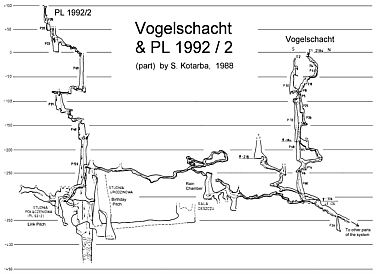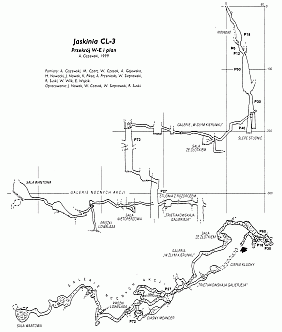
Since 2001.01.06 Lamprechtsofen is no longer deepest cave in the world. It was beaten by Voronya cave reexplored by Ukrainian - Russian team in Arabica massif in Caucasus mountains in Georgia. You can see actual section drawing here. Exploration of Lamprechtsofen is still in progress, and extending the depth of this cave still is possible. For geological reasons it can reach about 1720-1750.
The Polish expedition linked cave labelled Pl-2 to Lamprechtsofen (the Leoganger Steinberge massif, the Northern Calcareous Alps, Austria) on 19 August. Andrzej Ciszewski was, as almost always in the past, the team leader. The expedition explored Vogelschacht cave, which has been a part of Lamprechtsofen since 1995. More than 1 km of new series was discovered. The series led to Pl-2 cave at the level of about -400 m. The new depth of Lamprechtsofen reached 1632 m. Thus Lamprechtsofen became the deepest cave in the world.

This achievement crowns 24 years of Polish exploration of the Leoganger Steinberge massif. In this time almost 30 Polish expeditions carried out exploration in the massif. They worked in Lamprechtsofen, as well as in Nebelsbergkar area on the slopes of the massif. The most significant steps in the exploration of Lamprechtsofen carried out by Polish cavers were: (1) 1979 - reaching the vertical extent 1022 m in Lamprechtsofen during climbing up from the cave entrance; (2) 1990 - linking of N-132 to Lamprechtsofen which became the deepest cave traverse (1484 m); (3) 10.08.1995 - linking of Vogelschacht to Lamprechtsofen which made the depth of 1532 m, Lamprechtsofen became the second deepest cave in the world; (4) 19.08.1998 - Lamprechtsofen became the first deepest cave in the world due to the link with Pl-2 cave.
Michal Gradziński
Caving Commission of Polish Mountaineering Association

This year the expedition started earlier than normal i.e., on July 20. In this way I wanted to get as much as possible of the time of our big team (20 peoples). Traditionally, expedition was split into two parts whose times of activity overlapped. On our arrival it turned out that the level of snow in the upper part of the karst cauldron was incredibly low, which gave us a hope of an effective exploration. It was very important to us and I made a decision that we would not explore Pl-2 cave this year but only attack Sala Deszczu (Rain Chamber), the most southern part of Vogelschacht cave. Bearing in mind the experience we gained in Sala Deszczu a year before we took foam rubber suits in case we had to climb in waterfalls. Fortunately, it was not necessary for us to use them because the snow level was low. Just after setting up a camp in Vogelschacht the first team climbed up 60 m in Rain Chamber. Then we had to continue our climbing almost vertically. During our next camp employing the system of traverses and descends we reached the beginning of one of waterfalls falling into the chamber. At that place had its beginning a large sequence of corridors which lead to the south.
Taking into account our last surveys we believed that we were at the distance of only 30-60 m from PL-2.
 After a short period of euphoria the situation began to complicate. The corridor running along the stream of water changed into a small clearing and a window we discovered later lead us into a system of galleries and meanders which turned north-east and after about 150 m turned south again. That passage was created in a rift far to the east. We could expect that that corridor drained off waters from the area of the west walls of Kuchelhorn and Birnhorn, where no bigger cave was found so far.
After a short period of euphoria the situation began to complicate. The corridor running along the stream of water changed into a small clearing and a window we discovered later lead us into a system of galleries and meanders which turned north-east and after about 150 m turned south again. That passage was created in a rift far to the east. We could expect that that corridor drained off waters from the area of the west walls of Kuchelhorn and Birnhorn, where no bigger cave was found so far.
After a few days we went again into a state of euphoria. The passage changed into a big pitch. The localisation and the depth of it suggested that it could be the last and not fully explored pitch in PL-2. After descending 150 m we reached the bottom of it and we definitely confirmed that it is not PL-2. But our hope of discovering the farther part of a new cave was not destroyed because after the next 20 m of descent we saw a window with white aragonite forms which are always created in parts with strong air stream. A bolt traverse let us reach that window. On the other side of it we found a number of short galleries with deep pitches between them. On the head of one of them the exploring team ran out of equipment.
On August 18 W. Czesak and T. Fiodorowicz descended to the bottom of that pitch. On their way back, while ascending, they found a spit. They thought that they reached Vogelschacht again somewhere. The next day J. Kucmierz and A. Przeniosło surveyed Studnia Urodzinowa (Birdthday Pitch, this 150 m deep) and descended again to the pitch explored by the previous team. They reached a window in a wall of the first pitch and they found themselves in a part of Big Galleries in PL-2. So, beating hypothetical several dozen of meters of rock needed to explore 1200 m of passages, chimneys and pitches.
Before the end of our expedition we attacked an entrance lying about 15 m higher than PL-2. We reached -40 and the end part of it is very close to the known part of Pl-2. But more important is the fact that it was possible for us to enter CL-3 cave, located 70 m higher than PL-2. We reached -60 m and stopped because we ran out of time. We reached an area where it will be very difficult to explore deep caves without using explosives. (So far we have not used any explosives in Lamprechtsofen exploration). After making the connection between those caves everybody was very happy and full of optimism and I think we will link next caves in near future though the ridge is very close.
Andrzej Ciszewski, photos Stanislaw Kotarba

This was the 29 Polish expedition to Lampechsofen since 1974. Most of them was lead by Andrzej Ciszewski. In the expedition took part: Andrzej Ciszewski (leader), Marcin Czart, Wojciech Czesak, Agnieszka Gajewska, Marcin Gala, Tomasz Fiodorowicz, Jan Kucmierz, Pawel Migala, Henryk Nowacki, Jakub Panek, Krzysztof Piksa, Marcin Pruc, Anna Przenioslo, Krzysztof Recielski, Przemyslaw Sekowski, Rafal Suski, Stanislaw Wasyluk, Ewa Wojcik and Jerzy Zygmunt.

As usual, an expedition led by Andrzej Ciszewski operated in the Leoganger Steinberge massif in July and August 1999. The goal was to extend upwards the Lamprechtshofen system. Exploration began at -400 m in PL-2 (the highest part in Lamprechtshofen). As the place seemed of little promise, the team moved to CL-3, whose entrance lies 61 m higher than PL-2. Digging in blocks opened way to a series of pitches leading to -200 m. Wide galleries and pitches, mostly eastward trending, were then explored. In total more than 1.5 km of galleries have been discovered (mostly on -300 level) in CL-3 but they led in a wrong - not nonherly - direction. Kinderschacht (above PL-2) and Lodowa Jaskinia - 23 m above CL-3 - were also explored. Large dimensions of CL-3 passages give promise of extending system to the south to the close ridge of massif (200-300 m horizontally and 50-60 m higher), or to another side of ridge.
 Lampo
2000 Expedition
Lampo
2000 Expedition Team of eighteen cavers from KKTJ, led as usual by Andrzej Ciszewski, explored
the upper part of the Leoganger Steinberge (Northern Calcareous Alps). The aim
of the expedition was to search for a connection between Lamprechtsofen the
world's deepest cave - and other caves situated above it. The expedition started
on 22th of July. The main explored objects were cave CL3 with entrance 61 m
above the Lamprechaofen's highest entrance (PL-2) and Jaskinia Lodowa (Ice Cave)
situated another 25 m higher. CL-3 was discovered by Polish cavers in 1997 and
pushed to -350 in 1999. The Ice Cave is known lince 1981 and the main problem
there is a squeeze which possibly might bypass the ice chock at the cave's bottom.
This year's expedition discovered one kilometer of new galleries, including
the 120 m deep Studnia Bez Dna (Bottomless Pit), and deepened CL3 to ca. 600
m. There are still four leads left in the cave. The comparison of maps of Lamprechtsofen
and the Ice Cave shows that the lowest explored points in CL3 lie beneath the
wide galleries in the upper part of Lamprechaofen. The exploration in the Ice
Cave was unsuccessful.
Sections of CL-3, click for bigger version.

BACK TO MAIN PAGE:
here you can go back to english version index page.
| Visited times since 1998.08.31 | Last changed 2001.03.29 |